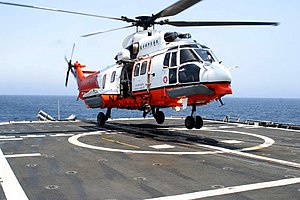Eurocopter AS332 Super Puma
| AS332 Super Puma | |
|---|---|
| An AS332 L2 from Hong Kong Government Flying Service (HKGFS) touches down on the USS Mobile Bay (CG-53) | |
| Role | Medium Utility Helicopter |
| Manufacturer | Aérospatiale Eurocopter Indonesian Aerospace (under license) |
| First flight | 13 September 1978 |
| Status | Active |
| Primary user | CHC Helicopter |
| Unit cost | US$15.5 million, €12.5 million (2006) |
| Developed from | Aérospatiale SA 330 Puma |
| Variants | Eurocopter AS 532 Eurocopter EC225 |
Design and development
In 1974, Aérospatiale commenced development of a new medium transport helicopter based on its SA 330 Puma, announcing the project at the 1975 Paris Air Show. While the new design was of similar layout to the AS 330, it was powered by two of the new and more powerful Turbomeca Makila turboshaft engines powering a four-bladed composite main rotor, and was designed to be withstand damage better, with a more robust fuselage structure, a new crashworthy undercarriage and the ability to withstand battle damage to the rotor blades and other key mechanical systems.[1] It was fitted with a ventral fin under the tail a more streamlined nose compared with the SA 330,[2] while from the start was planned to be available with two fuselage lengths, with a short fuselage version offering similar capacity to the SA 330, which gives better performance in "hot and high" conditions and a stretched version allowing more passengers to be carried when weight is less critical.[3]A pre-production prototype, the SA 331, modified from a SA 330 airframe with Makila engines and a new gearbox, flew on 5 September 1977.[4] The first prototype of the full Super Puma made its maiden flight on 13 September 1978, being followed by a further five prototypes.[5]
The type has proved immensely successful, chosen by 37 military forces around the world, and some 1,000 civil operators.[citation needed] The Super Puma has proved especially well-suited to the North Sea oil industry, where it is used to ferry personnel and equipment to and from oil platforms. In civilian configuration it can seat approximately 18 passengers and two crew, though since the early 2000s most oil companies have banned use of the middle-rear seat reducing effective capacity to 17+2. This down-rating is due to difficulties encountered in evacuating through the rear-most windows in crashes at sea.
A wide variety of specialised military variants are in use, including dedicated Search and rescue (SAR) and Anti-submarine warfare (ASW) versions. Since 1990, military Super Pumas have been marketed as the AS532 Cougar.
Operational history
VH-34

President Lula arrives at Brasília Air Force Base (BABR), on a Brazilian Air Force VH-34
Variants
- SA 331
- Initial prototype, based on SA 330 airframe, first flew on 5 September 1977.[5]
- AS 332A - Commercial pre-production version.
- AS 332B - Military version.
- AS 332B1 - First military version.
- AS 332C - Production civil version.
- AS 332C1 - Search and rescue version, equipped with a search radar and six stretchers.
- AS 332F - Military anti-submarine and anti-ship version.
- AS 332F1 - Naval version.
- AS 332L - Civil version with more powerful engines, a lengthened fuselage, a larger cabin space and a larger fuel tank.
- AS 332L1 - Stretched civil version, with a long fuselage and an airline interior.
- AS 332L2 Super Puma Mk 2 - Civil transport version, fitted with Spheriflex rotor head and EFIS.
- AS 332M - Military version of the AS 332L.
- AS 332M1 - Stretched military version.
- NAS 332 - Licensed version built by IPTN, now Indonesian Aerospace (PT. Dirgantara Indonesia).
- VH-34 - Brazilian Air Force designation for the two VIP configured Super pumas, serial numbers 8737 and 8740
Operators
Civilian
- Bristow Helicopters Ltd - operates a fleet for North West Shelf hydrocarbon personnel transfer operations
- 2 AS 332L1's in service with Azerbaijan Airlines (AZAL) and used for offshore operations to ferry workers to and from Caspian Sea oil rigs, and to transport passengers.[7]
- Used by Petrobras Oil
- Three aircraft in use with the Finnish Border Guard.[8]
- CITIC Offshore Helicopter (COHC)
- Government Flying Service - operates 3 AS332L2 for SAR operations and transport for Hong Kong Police
- Malaysia Helicopter Services - chartered by PETRONAS for its upstream operations offshore the states of Terengganu and Sarawak.
- British Airways Helicopters (1983–1986)
- Bristow Helicopters Ltd - operates a fleet of around 20 airframes for North Sea hydrocarbon personnel transfer operations
- Bond Offshore Helicopters
- CHC Scotia Helicopters
- Los Angeles County Sheriff's Department (2011–Present) - Operates 3 Super Pumas primarily as the main rescue helicopters known as Air Rescue 5. Replaces their Sikorsky H-3 Sea Kings towards the middle of 2012.
- Puerto Rico Electric Power Authority - Utilises one AS332C, N5800Z, for powerline construction and external load operations
Military

AS 332M Super Puma of 125 Squadron, Republic of Singapore Air Force.

AS 332 of Brazilian Navy.

AS 332 of Brazilian Air Force
- Argentine Army 3 AS-332B
- Brazilian Air Force (532MK1)
- Brazilian Army (532UE)
- Brazilian Navy (532MK1)
- Chilean Army (332M)
- Chilean Navy (332F1)
- Ecuadorian Army (332M)
- Flugbereitschaft des Bundesministeriums der Verteidigung (German Air Force)
- Greek Air Force (332C1)
- Icelandic Coast Guard (operates 3 - AS 532U2)
- Royal Jordanian Air Force (332M)
- Kuwait Air Force (332M)
- Mexican Air Force - for VIP transport.[12]
- Nigerian Air Force (332B)
- Saudi Navy (332F)
-
- 125 Squadron operates 22 AS332M Super Pumas
- Spanish Air Force (332B and 332M)
- Spanish Army (332B)
- Swiss Air Force (332M)
- Venezuelan Air Force (332B)
- Vietnam People's Air Force (332L)
- Bolivian Air Force (332M)
Specifications (AS332 L1)
General characteristics
- Crew: 2
- Capacity: 19
- Length: 16.29 m (53.44 ft)
- Rotor diameter: 15.6 m (51.18 ft)
- Height: 4.80 m (15.09 ft)
- Empty weight: 4,500 kg (9,920 lb)
- Useful load: 4,100 kg (9,040 lb)
- Max. takeoff weight: 8,600 kg (18,960 lb)
- Powerplant: 2 × Turbomeca Makila 1A1 turboshaft, 1,300 kW (1,742 shp) each
- Never exceed speed: 278 km/h @ 8,600 kg gross (150 kt)
- Maximum speed: 262 km/h @ 8,600 kg gross (141 kt)
- Cruise speed: 252 km/h @ 8,600 kg gross (136 kt)
- Range: 841 km @ 8,600 kg gross (454 nm)
- Service ceiling: 6,100 m (20,000 ft)
- Rate of climb: 8.2 m/s @ 70 kt & 8,600 kg gross (1,620 ft/m @ 70 kt)
Specifications (AS332 L2)
General characteristics- Crew: 2
- Capacity: 24 passengers plus attendant
- Length: 16.79 m (including tail rotor) (55 ft 0½ in)
- Rotor diameter: 16.20 m (53 ft 1½ in -rotates clockwise)
- Height: 4.97 m (16 ft 4 in)
- Disc area: 206.12 m² (2,217 ft²)
- Empty weight: 4,660 kg (10,274 lb)
- Useful load: 4,490 kg (9,899 lb)
- Max. takeoff weight: 9,150 kg (20,172 lb)
- Powerplant: 2 × Turbomeca Makila 1A2 turboshaft, 1,376 kW (1,845 shp) each
- Never exceed speed: 327 km/h (177 knots, 203 mph)
- Maximum speed: 277 km/h (150 knots, 172 mph) (max cruise)
- Cruise speed: 247 km/h (133 knots, 154 mph) (econ cruise)
- Range: 851 km (460 nmi, 529 mi)
- Service ceiling: 5,180 m (16,995 ft)
- Rate of climb: 7.4 m/s (1,447 ft/min)
















0 Comment:
Posting Komentar